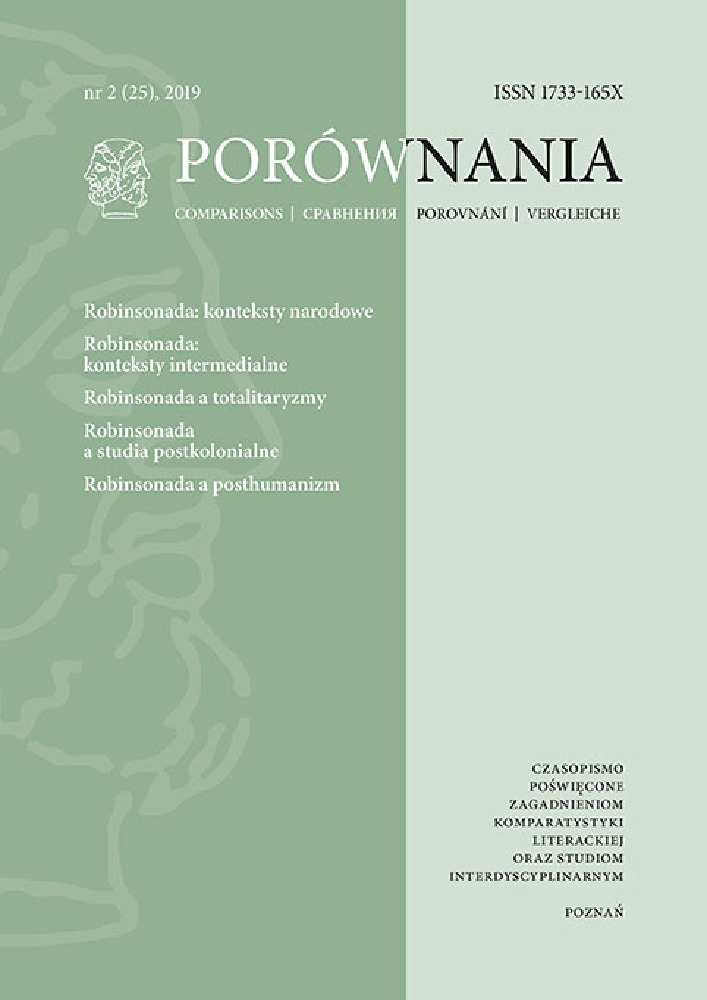Abstract
Tim Crouch’s I, Caliban is a postdramatic adaptation of Shakespeare’s The Tempest included in a collection titled I, Shakespeare in which he recreates Shakespeare’s most marginalised characters. The focus in this sequel adaptation is on Caliban who tries to survive after Prospero and all others have left the island. Different from the representation of Caliban in postcolonial reworkings of Shakespeare’s play, Caliban, in this work, is not preoccupied with taking revenge. Instead, he emphasises the need for social interaction as he has been left alone on his island. Drawing on former structural comparisons of The Tempest and Daniel Defoe’s Robinson Crusoe based on their common themes such as the island setting, master-servant relationship, colonial expansion, and power politics, the aim of this paper is to discuss Crouch’s adaptation as a transformation of common motifs of the Robinsonade in its attempt to respond to the ideological
formations of Shakespeare’s text. Among such transformations, the concept of survival, for instance, is handled from the native’s viewpoint in Crouch’s work. Instead of the figure of the stranger who finds life on an unknown land difficult to cope with, this time, the native turns into a captive on the island though it is a familiar setting. Another motif used in an alternative manner is isolation, which is not presented as fuel for civilisation but as Caliban’s psychological trauma, which he explores through storytelling as a postdramatic element. Apart from the narration, the play demonstrates other uses of postdramatic elements to suggest an isolated figure on an uninhabited island like the use of objects such as toy boats and tape of sea sounds. Instead of seeing Crouch’s work as a postcolonial response to Shakespeare’s work, this paper will try to investigate how the use of island setting and the theme of isolation can make it closer to a Robinsonade. By this means, it will also try to ask whether an adaptation could also be read in relation to a work that is not intended as its source text.
Literaturhinweise
Bertsch, Janet. Storytelling in the Works of Bunyan, Grimmelshausen, Defoe and Schnabel. Columbia, SC: Camden House, 2004.
Crouch, Tim. I, Shakespeare. London: Oberon, 2012.
Defoe, Daniel. Serious Reflections During the Life and Surprising Adventures of Robinson Crusoe: With his Vision of the Angelic World Written by Himself. London: W. Taylor, 1720.
Moore, John Robert. “The Tempest and Robinson Crusoe.” The Review of English Studies 21(81) (1945). 52-56. Web. 04.09.2019. https://www.jstor.org/stable/pdf/508999.pdf?refreqid=excelsior%3Abe40ee923f2ade7c1e793bbad048f98a.
Richetti, John. The Cambridge Companion to ‘Robinson Crusoe.’ Cambridge: Cambridge UP, 2018.
Rousseau, Jean-Jacques. Emile. London: Dent, 1948.
Scott, Helen C. Shakespeare’s Tempest and Capitalism: The Storm of History. London: Routledge, 2019.
Smith, Michelle J. “Microcosms of Girlhood: Reworking the Robinsonade for Girls.” Empire in British Girls’ Literature and Culture: Imperial Girls, 1880-1915. Houndmills, Basingstoke, Hampshire: Palgrave Macmillan, 2011. 159-180.
Vaughan, Virginia Mason, and Alden T. Vaughan. Introduction. The Tempest.
William Shakespeare. London: Arden Shakespeare, 1999. 1-133.
Lizenz
Utwory opublikowane w czasopiśmie „Porównania”, na platformie Pressto należącej do Uniwersytetu im. Adama Mickiewicza w Poznaniu są udostępniane na licencji Creative Commons Uznanie autorstwa - Bez utworów zależnych 4.0 Międzynarodowe (CC BY-ND 4.0)
Tym samym wszyscy zainteresowani są uprawnieni do korzystania z utworów opublikowanych pod następującymi warunkami:
-
uznania autorstwa — czyli obowiązek podania wraz z rozpowszechnianym utworem informacji o autorstwie, tytule, źródle (odnośniki do oryginalnego utworu, doi) oraz samej licencji
-
bez utworów zależnych — remiksując, przetwarzając lub tworząc na podstawie utworu, nie wolno rozpowszechniać zmodyfikowanych treści.
-
brak dodatkowych ograniczeń — nie można korzystać ze środków prawnych lub technologicznych, które ograniczają innych w korzystaniu z utworu na warunkach określonych w licencji.
Uniwersytet im. Adama Mickiewicza w Poznaniu zachowuje prawo do czasopisma jako całości (układ, forma graficzna, tytuł, projekt okładki, logo itp.).
Autor zachowuje prawa majątkowe, ale udziela zgody Uniwersytetowi im. Adama Mickiewicza w Poznaniu na wykorzystanie dzieła. Autorzy tekstów zakwalifikowanych do publikacji proszeni są o wypełnienie podpisanie i przesłanie umowa (PL) agreement (EN)
Agreement for granting a royalty-free license to works with a commitment to grant a CC sub-license




